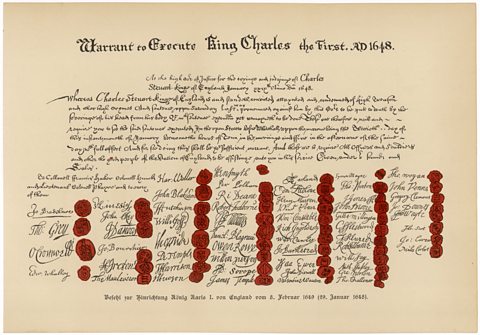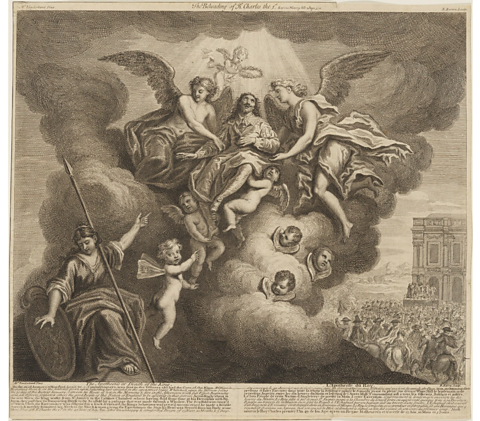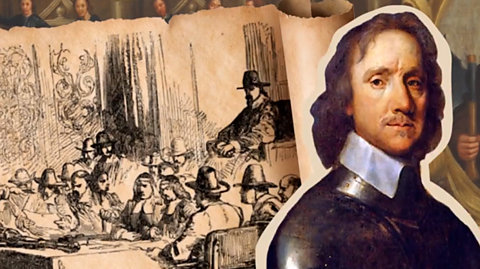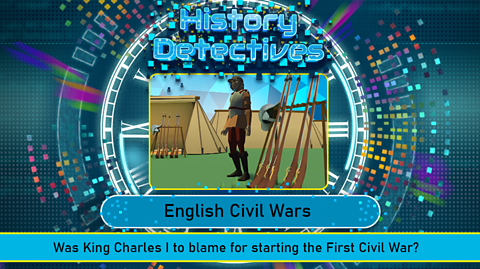Key points
- In 1649, King Charles I was put on trial for treason.
- He was found guilty and sentenced to death.
- Even though Charles had fought against Parliament, only 59 commissioners signed Charlesт death warrant.
Key events in the trial and execution of Charles I
Game - Charles I
Play a History Detectives mission exploring Charles I's role in starting the English Civil Wars.
You can also play the full game.
The trial
Following the end of the Second Civil War in 1648, Charles began negotiations with some MPMember of Parliament- a politician who represents a particular area of the country, known as a constituency, and votes on laws. over his role. They hoped there could be an arrangement where Charles could remain as king but with some restrictions over his power. However, Thomas FairfaxFairfax was a politician who became commander-in-chief of the Parliamentarian forces during the English Civil Wars. had ended discussions by storming into Parliament and would only allow MPs who wanted Charles to answer for his role in the Civil War to attend. This was known as the тRump Parliament.т They decided that Charles should be put on trial for treasonCommitting a crime that betrays your country..
The trial of Charles I started on 20 January 1649. There should have been 135 commissionersJudges at the trial of Charles I. They were mainly, but not all, Members of Parliament. involved in the trial, but only 68 actually turned up. The House of Lords refused to support the trial, so only members of the House of Commons formed the commission. The chief judge was John Bradshaw. John Cook was given the role of leading the prosecutionBringing legal action against a person on the basis of criminal charges..
Charles refused to recognise the right of the court to put him on trial, saying only God could judge a king. He was asked to enter a plea on three occasions, but refused to do so. This suggested Charles still believed in the Divine Right of KingsThe belief that a king or queen had been put in charge by God. This was important in showing the authority and power of the monarch.. Many MPs were nervous about putting Charles on trial. The crime of killing a king was known as regicide. The trial lasted for a week, and on 27 January the court found Charles guilty, sentencing him to death. Only 59 of the 68 commissioners who attended the trial signed the death warrant.

The execution
Charles was sentenced to death on 30 January 1649. The execution took place on a specially erected platform in front of the Banqueting House in London. In the morning, he requested an extra shirt, as he did not want to be shivering in the cold; he worried that people would think he was shaking with nerves. Charles maintained his innocence, and on the platform before his execution, he claimed that he was a тmartyrA person who suffers greatly or is killed for their beliefs or principles. of the people.т The executioner wore a hood, making him anonymous. Their identity was never revealed.
After his execution, the executioner dropped Charlesт head in front of the platform, where members of the crowd dipped handkerchiefs in his blood and cut locks of his hair. Charlesт body was taken to Windsor and buried in St Georgeтs Chapel, alongside Henry VIII.
Following Charlesт trial, there was an 11-year period when England was ruled without a monarch. Oliver Cromwell led England from 1653, taking the title of тLord Protectorт. He was succeeded briefly by his son, Richard Cromwell. When Charles II was crowned in 1660, 39 of the 59 commissioners who had signed his fatherтs death warrant were still alive. He ordered that they should be put on trial for regicide.
The death of a king: different perspectives

The Royalist view
The engraving above was produced in 1725, 76 years after the execution of Charles I. In the bottom right hand corner is the Banqueting House and the execution taking place.
The main part of the picture shows Charles ascending into heaven. On both sides of him are 2 angels, and the light of heaven is shining on him. A cherub is placing a crown on his head. In the bottom left corner is a figure representing Britannia. She is looking away, showing she is upset at the execution. The name of the engraving is тThe Apotheosisт, or тThe Death of a King.т тApotheosisт is a Greek word, meaning тto make someone a God.
The name of the engraving, and the symbolism in it, shows that the artist believes it was wrong to execute Charles. It has been produced to deliver a message, or opinion, rather than as an accurate picture of the events of 30 January 1649.
The prosecutor's view
Following the execution of Charles, many people in England and abroad were uncertain about whether it was the right thing to do.
John Cook was the lead prosecutor at Charles Iтs trial. After the execution, he produced a pamphlet to justify the actions of the court in prosecuting, and killing, the king. In this pamphlet, he said:
тI will be bold to say (which I hope God guides my hand to write) This High Court hath cut off the head of a Tyrant, and they have done well; undoubtedly it is the best action that they ever did in all their lives.т
What can you find out about John Cook's opinion on Charles' execution from this source?
John Cook uses vocabulary such as тtyrantт to show why Charles needed to be punished. The phrase тI hope God guides my handт suggests that he believes God was helping the commissioners to make their decision in sentencing Charles to death.
Although clearly biased, this account is useful to historians in showing how those involved in Charlesт execution justified their actions.
Test your knowledge
Play the History Detectives game! gamePlay the History Detectives game!
Analyse and evaluate evidence to uncover some of historyтs burning questions in this game.

More on The English Civil Wars
Find out more by working through a topic
- count3 of 3

- count1 of 3

